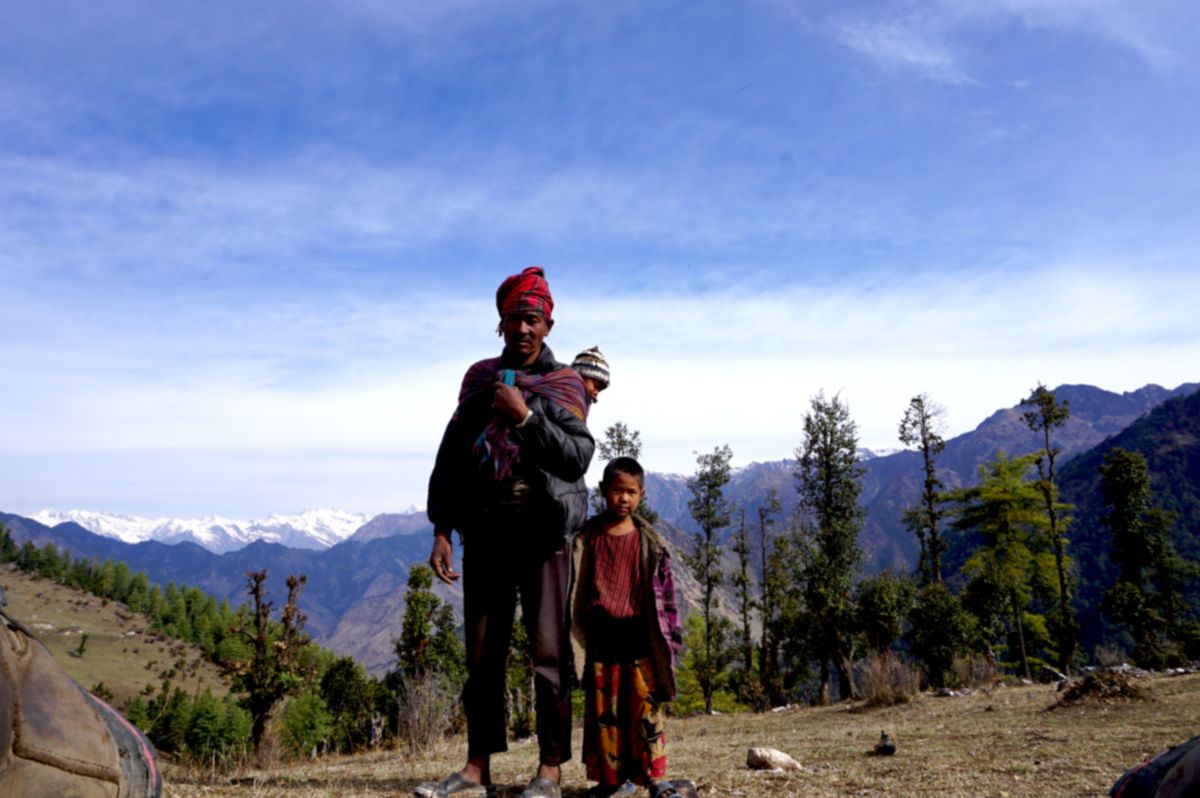Wilderness Adventures
Extreme mountain hunting in Nepal
Hunting in Nepal is something that only few hunters get to experience, not only because of the logistics and expenses involved, but also because of the few hunting licenses that are being issued each year. However, if one gets the chance, the country offers some of the most breathtaking mountain hunting experiences you can get. Quite literally.
We have been walking for several days. It has been laborious and challenging, physically as well as mentally. But finally, we find ourselves in the core area where the tahr are found.
Actually, the hunter and the 22 sherpas – as carriers are called in the Himalayas – has made it about 15-20 km this day, as the crow flies, and as most will know, the tahr lives in high mountain. Many of these kilometers have therefore been covered climbing the steep curves, either up or down.

“Finally, the tahr arrives, presenting his shoulder for a perfect shot placement. The hunter aims and sets the crosshairs on the brown, long-haired shoulder.”
Since there is not a single horizontal place in the terrain, some of the sherpas are shoveling gravel and stones away, in order to create a fairly comfortable tent camp. They work at a pace that clearly shows that this mountain population is made of a very special fabric: Many of them are capable of carrying more than their own weight in baskets on their backs or in a kind of headband.
As the camp is being established, the hunter and his two guides, Man Pun Magar and Jug Bahadur Budhamagar, climbs the mountain to spot for tahr before tomorrow's hunt. The hunter immediately begins glassing the terrain with his modern optics, while Jug raises his ancient binoculars that most of all resembles a small binocular, made for the opera.
Jug is a former poacher who now, due to the money supplied to the area from trophy hunting, is engaged in guiding foreign hunters. He knows every mountain top and he quickly spots four bulls in a small group far away. A little later, he locates three more another place.
Apart from the tahr, they also spot the exclusive Blue Sheep and some Goral, that is an Asian species of chamois.
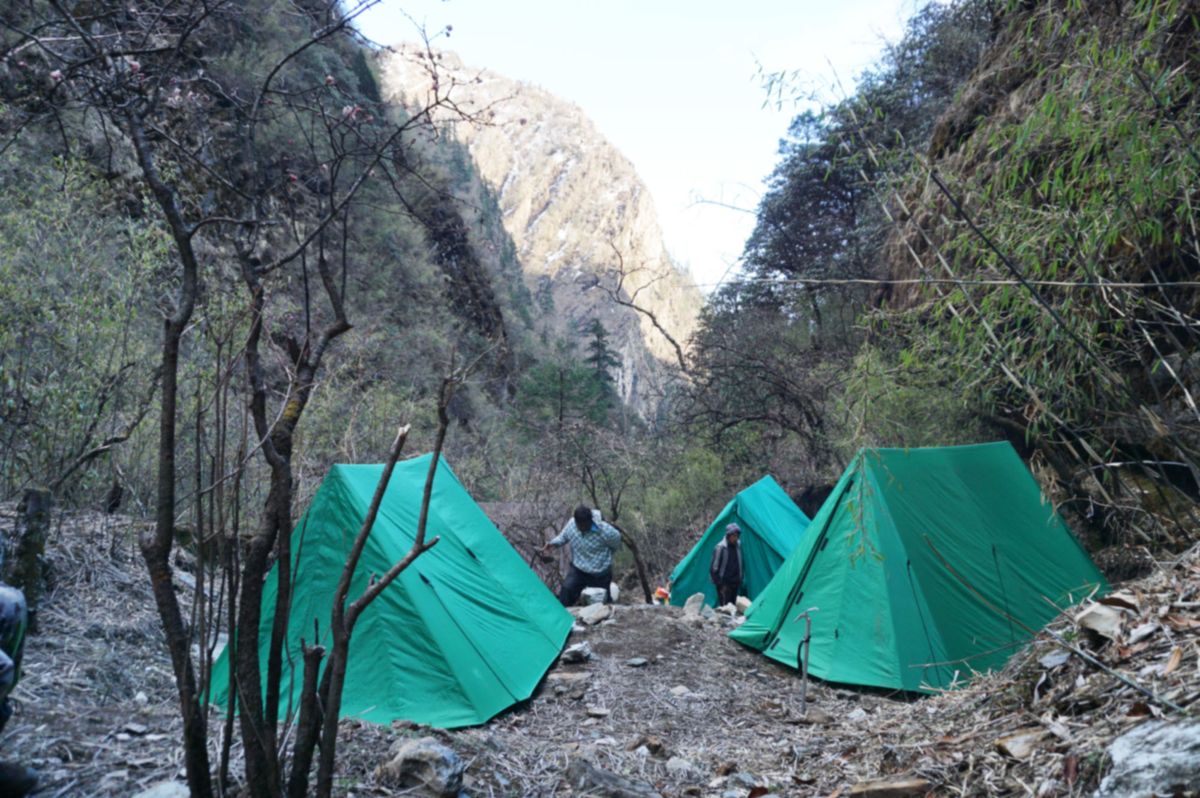

A costly affair
Thousands of hunters have over the years visited New Zealand's mountains to hunt tahr: among European hunters, that destination has in recent years become very popular. But unlike a tahr hunt in New Zealand, which doesn’t empty your bank account, hunting in Nepal is considered costly. This is partly due to hunting logistical challenges, the many sherpas and guides involved, as well as taxes to the state.
The tax for shooting one tahr is 1.500 US dollars, while a Blue Sheep requires a fee of 2.000 US dollars. These fees go to local areas in which the hunting takes place and are used for the construction and operation of schools, which in a country like Nepal – among the poorest in the World – makes a great difference. In addition, trophy hunting in general helps ensure the survival of the hunted species and aids in biotope conservation all over the World.
Currently, the only possibility of hunting in Nepal is in a reserve called Dhorpatan. Here, it is possible to hunt species such as the Himalayan tahr, Blue Sheep (Tibetan Bharal), Indian muntjac deer and wild boar. Species like Goral and Himalayan Serow are numerous in the area, but hunting those type of game is currently not allowed.


Shot Distance – 344 meters
After a good night's sleep in the primitive tent, the guides wake up the hunter. They would like to begin the ascent before daybreak. At first light, they are ready on the mountain with spotting scope, binoculars, and stiff glances. Jug is again the first to spot a tahr, while the hunter – like it is when you hunt new species in a new habitat – has a harder time spotting the animals.
Jug tries with his broken English to guide the hunter in the direction where he has seen the animal, but without success. By randomly gliding the spotting scope across the hillside, first on the other side of the valley, then closer, the hunter suddenly sees the tahr. The tahr is located at a completely different place than from what he had understood from Jug – it is much closer than he expected, and definitely within shooting range.
Silently the hunter climbs to the edge of a gently sloping rock, sets up the bipod, measures the distance and finally gets ready to take his shot.
The distance is 344 meters. The hunter has trained countless shots at all distances from 100 meters out to 400 meters, and he knows his rifle, ammunition and ballistics ad nauseam. He is comfortable with taking the shot. He loads the rifle and places his finger on the trigger. However, the animal suddenly jumps 30 meters further up the hillside and disappears in a rhododendron thicket.
The animal reappears, but the hunter is only able to see the top of the horns in the shrub. Just as the hunter thinks that his chance is wasted, the animal moves again. If it will move just 40 meters more in the same direction, it will clear the bushes and get out into the open where the hunter can take a shot.
High altitudes, high tree line
A hunt like this can without exaggeration be categorized as one of the toughest in the World. Just to get to the hunting area can be struggle. A hunting trip like this can easily last up to three weeks. This is mainly because the roads to the hunting area are steep and almost impassable, and may only be traversed in a combination of long detours with 4WD and simple walking.
Without three weeks available, a hunting trip can be done in two, if the first part of the tour is made by helicopter. This is however very expensive and costs about 5.000 US Dollars on top of everything else. Although the hunter has selected the helicopter solution, he must still be in very good physical shape and count on many days of hiking the steep mountain sides, both during the hunt and when the camp is moved around, depending on the species hunted.
The hunt takes place at altitudes where oxygen pressure is very low, which was emphasized during the helicopter ride into the mountains. On the flight, the GPS showed 3.500 meters and the pilot with fumbling fingers mounted oxygen tubing under his nose.
While Jens waits for the tahr to come right up to the edge and offer a chance at a shot, there's time to enjoy the view of the infinitely beautiful mountains. Despite the altitude of the Himalaya Mountains, there are still rhododendron- and bamboo forests up here, which grow well above the tree line that are seen in the European mountains.
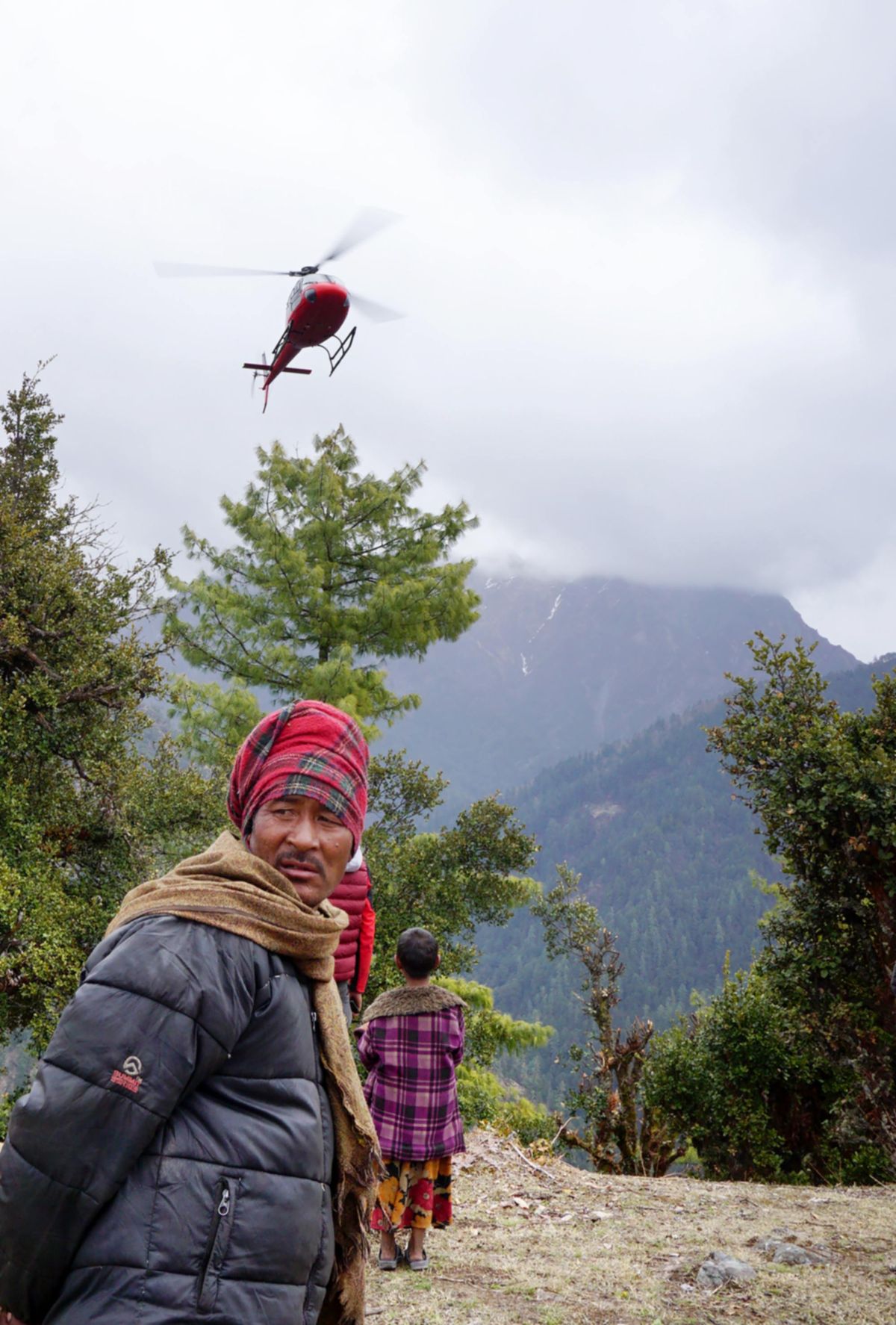
Not for granted
Finally, the tahr arrives, presenting his shoulder for a perfect shot placement. The hunter aims and sets the crosshairs on the brown, long-haired shoulder. When he pulls the trigger, the 7mm Rem. Mag. recoil pushes his head back a little. When the hunter gets back on the target, he cannot see the animal, as it is neither lying on the shot site nor running over the mountain in a dead run – where is it?
Then the hunter senses a movement. The animal is coming full speed out of rhododendron bushes. In the binoculars, he can see that he has made a deadly shot as lung blood colors the tahr’s nostrils red. But Jug wants him to give it another shot, to stop it from going further down the mountain. The only problem is that he again fails to see the animal, which is incredibly well covered into its surroundings.
The hunter is about to panic, as the animal once again disappears after a short appearance. Then Jug presses the barrel down a little to the right, and suddenly it points directly on the target. Although the animal has stopped and seems about to fall, the experienced hunter takes another shot – this time on the neck. The animal falls down, dead, and completes a long and adventurous hunt.
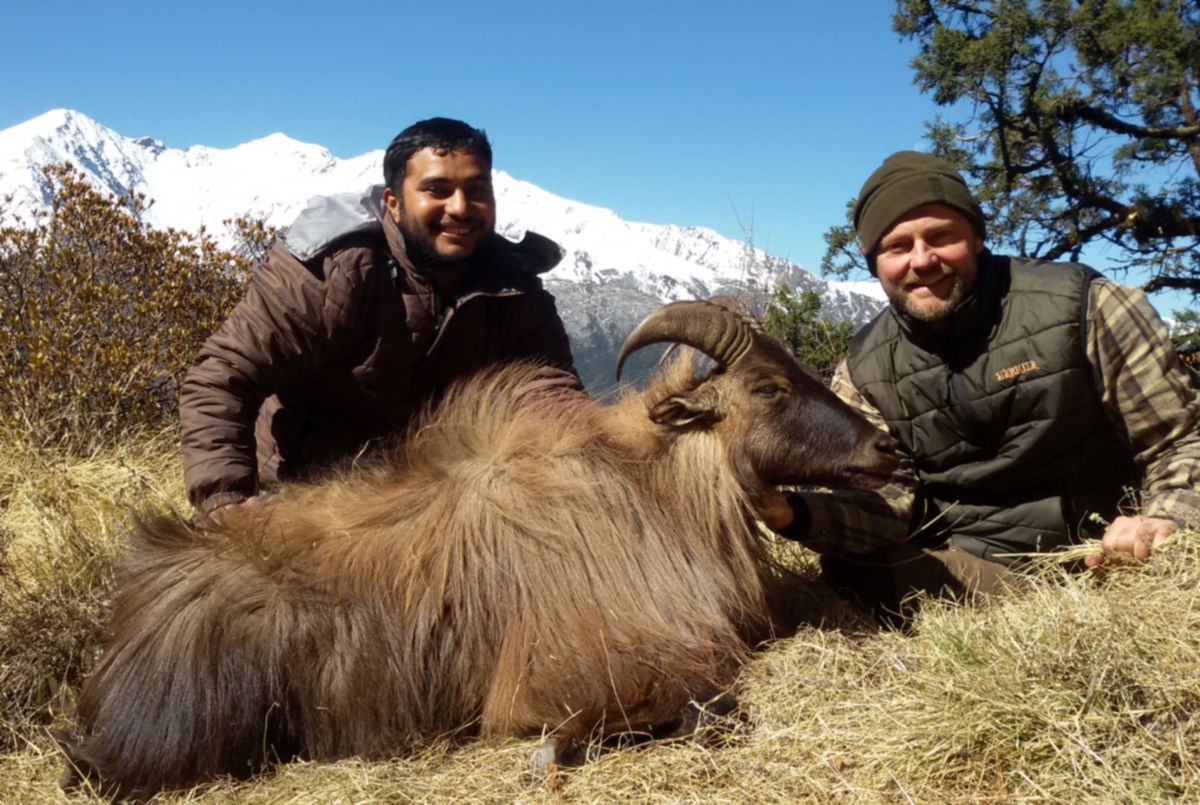
Hunting in Nepal
The hunting season in Nepal is very road dependent, but usually October, November and March will be good months to plan the trip. You cannot hunt on your own in Nepal, and all hunting in the country should be organized by booking through a hunting agency or even better, directly through the outfitter. There are very few hunting travel agents who have experience with hunting in Nepal, so you will often have easier access to important and useful information by booking directly with one of the three or four reputable outfitters found in Nepal. They all have foreign customers through every year and perform with high success rates. The hunt described here was booked at:
Global Safaris Nepal
Post Box: 20132, Thamel-29, Kathmandu, Nepal.
Tel.: + 977-9851162503 (Mr. Samsher Para July)
Web: www.huntnepal.com
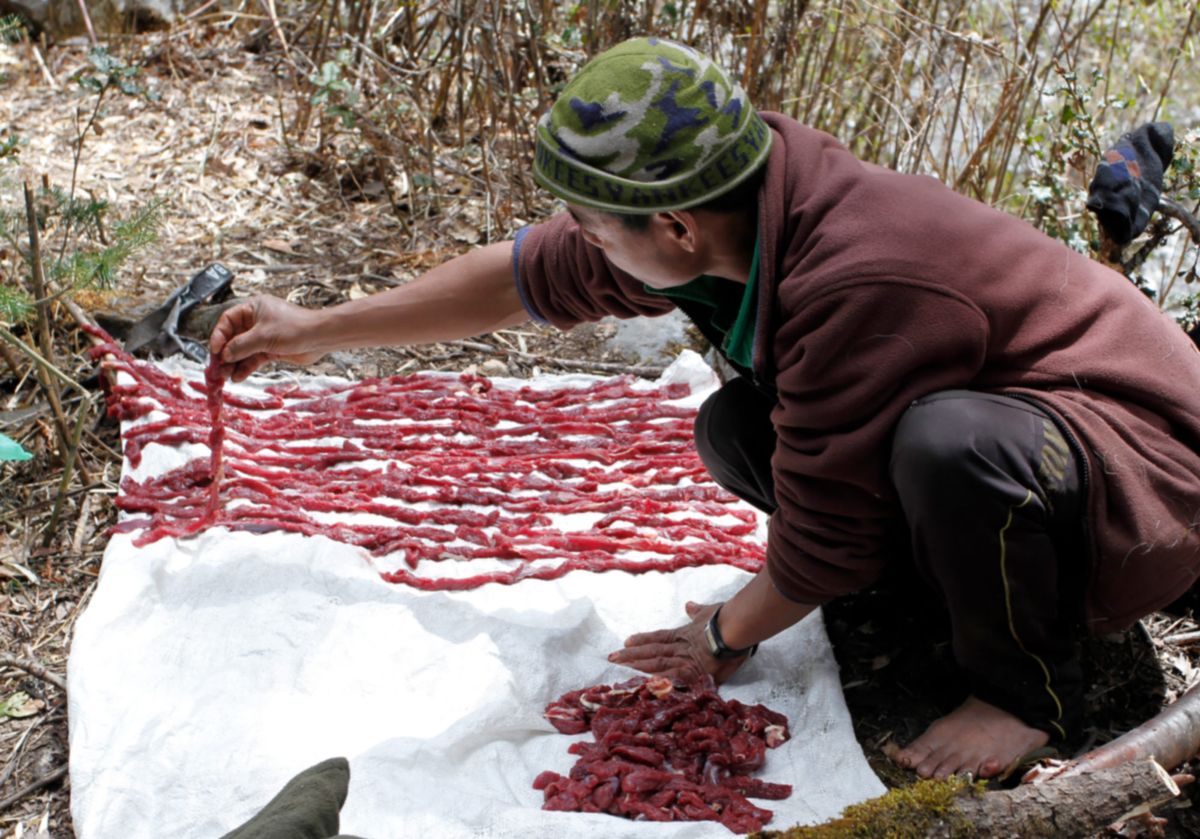

Himalayan tahr
The Himalayan tahr originates from the Himalayan mountain range that runs through five countries – India, Nepal, Bhutan, China and Pakistan. The mountain range has nine of the 10 highest peaks in the world – including the highest, Mount Everest at 8.848 meters. Himalayan tahr live in mountainous terrain and in this part of the World at altitudes between 3.500 and 5.200 meters, depending on both the season and the time of day. In winter, they by nature move toward the lower slopes to avoid the deep snow. Himalayan tahr were introduced to New Zealand in 1904, and the vast majority of trophies of this kind today are shot there. In New Zealand, the species is usually found on hillsides and scrub at altitudes from 750 to 2.250 meters. Nepal issues only about 20 hunting licenses to Himalayan tahr per year.
Nepal in numbers
Nepal is a landlocked country, located in the Himalayas. The country, which in the North borders with China and in the South, East and West with India, has an area of 147.181 square kilometers. There live about 27 million people in Nepal, of which one million live in the nation's capital, Kathmandu, located at an altitude of 1.400 meters. Nepal is home to more than 240 mountain peaks, towering more than 6.000 meters above sea level. Annually, the country is visited by thousands and thousands of trekking tourists and mountaineers from around the World.


